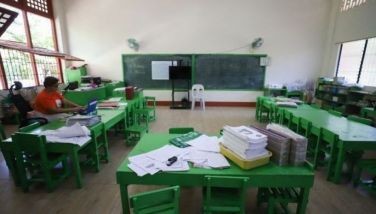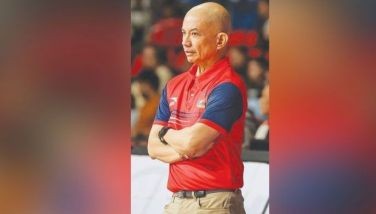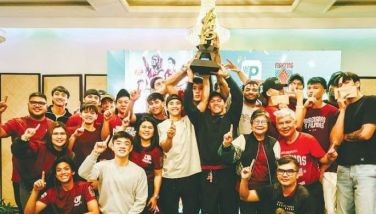Kintanar: At home in a new life
January 24, 2003 | 12:00am
(Newsbreak magazine ran this story about Romulo Kintanar in its April 1, 2002 issue.)
Sometime in 1985, a core of communist cadres hatched a plot that they hoped would bring Ferdinand Marcos to his knees: seize the Batasang Pambansa in Quezon City, hold hostage the entire parliament in session, and force him to negotiate.
The guerrillas would demand the release of all political prisoners, led by their founding chairman, Jose Ma. Sison. Since Marcos had grown so unpopular, the unstated objective of the plot was obvious: to spark a revolt against his regime.
For six months, the rebels planted spies at the Batasan, mastered its building plan, and recruited the best-trained fighters for the operation. They proposed a P1-million budget, and even planned to buy tiny packs of energy food they had discovered in Hong Kong — in case the hostage drama dragged.
Romulo "Rolly" Kintanar, chief of the New People’s Army (NPA) at the time, initiated the plot, encouraged by some senior leaders of the Communist Party of the Philippines (CPP), including the jailed Sison.
But Rodolfo Salas, then the acting CPP chairman, rejected it. To him, it had all the makings of an insurrection, which party conservatives believed went against the Party’s protracted-war strategy.
When his troops were ready to go, Kintanar got stern orders from party bosses: Forget it.
The NPA chief delivered the bad news to his men, but advised them to move on as there were other tasks to accomplish.
"I cried… we worked so hard for that," recalls a former senior NPA officer who helped Kintanar with the botched plot and who revealed this plot to Newsbreak. "But like a good soldier, he (Kintanar) said this was all part of being a cadre… he even presented to us a new list of tasks to do, as if nothing happened."
In 1986 when people power I erupted, those in the know were left salivating over what might have been.
After the CPP suffered its worst split in 1991, which found Kintanar on the side of the opposition (or "rejectionists," in party parlance), Sison, CPP chairman in exile in the Netherlands, branded Kintanar as a "traitor, a military agent, utak-pulbura… one with brains of gunpowder."
The tag deeply hurt Kintanar, according to his former comrades. Says a former NPA leader: "He’s the reason I never went back to the movement. If the leadership could do that to someone like Rolly...."
After his release from prison in 1992, Kintanar never returned to the rebel army he once commanded and where he spent 25 years of his life.
Instead, he formed cooperatives, helped politicians win elections, worked as a consultant to the Estrada administration and – who could forget this? – raised the hand of presidential candidate Jose de Venecia Jr. in the 1998 elections.
At the time of his death, the 52-year-old Kintanar worked as security consultant to Immigration Commissioner Andrea Domingo, a former activist herself, and the National Electrification Administration. As NEA consultant, he helped the agency run after syndicates behind electrification projects in remote barangays.
Kintanar also served as adviser to his uncle, Cebu Rep. Simeon Kintanar, whom he helped win in the last elections. The congressman was up against a known warlord in Cebu so his nephew’s skills came in handy. The ex-NPA chief gathered all armed gangs of Cebu’s politicians and told them to behave in the elections. His warning: "Pag nandaya kayo, ako ang kalaban ninyo (If you cheat, I will be your enemy)."
Why did he render services to a politician? "For a good cause, for honest elections," Kintanar said. But when he backed De Venecia (now House speaker) in the 1998 campaign, he said, he did so because the cooperatives he was helping badly needed money. Kintanar kept on his payroll a core of former aides in the NPA.
"When I raised De Venecia’s hand, Sison and his allies criticized me for it," recalled Kintanar in Filipino. "Look at them now—Sison raised De Venecia’s hand during the peace talks and some of my critics are now in Congress. I prefer working behind the scenes."
Kintanar was 18, a freshman at the Ateneo de Davao, when he joined the NPA in 1970.
Belonging to a big, landed family, he persuaded his parents to distribute 100 hectares of their land in Davao and South Cotabato to their farmer-tenants. His first major task as a "political officer" was to bring a ragtag band of rebels to Palanan, Isabela, in 1972 where they would get hundreds of firearms smuggled from China aboard the M/V Karagatan.
A logger on board his plane spotted the stranded Karagatan off Isabela, prompting a huge deployment of air, sea, and ground troops to the area. Kintanar’s sparring partner then was soldier-turned-rebel Victor Corpus, who served as the NPAs’ commanding officer for that operation. Imagine this: less than a hundred rebels being pursued by 10,000 government troops. Only a handful of the guerrillas survived, but the incident sealed the friendship of Kintanar and Corpus, now the military intelligence chief.
Said Kintanar: "Pagkatapos ng Karagatan, sabi ko sa sarili ko maski limang taon lang ako sa hukbo, okay na, puwede na akong mamatay para sa bayan (After Karagatan, I told myself that even if I had only five years in the movement, I could die for the country)."
In his time, NPA members swapped endless, almost legendary stories about Kintanar. How, for example, as a platoon leader in Davao he stood in front of a military camp, waited for an Army truck to enter it, and ambushed it. He carted away weapons that gave the NPAs in Mindanao the first Armalites in their armory.
In 1989, he plotted his own escape from detention at Camp Crame – befriending the jail warden until the latter invited him to attend a party outside the jail. During the party, Kintanar and wife quietly walked to a waiting car and fled.
NPA’s growth
In 1985, after leading more than 100 battles mostly in Mindanao, Kintanar was promoted to chief of the NPA general command. Two years later, the NPA reached its peak of 25,000 armed regulars, a fact even his critics partly attribute to his military skills and leadership.
Duplicating the NPA’s tactics in Mindanao in other regions, Kintanar ordered his troops to conduct more raids and ambushes, and formed 33 guerrilla companies and six battalions nationwide. From 1987 to early 1988, he directed simultaneous military campaigns nationwide that coincided with protest actions in urban cities.
He even asked CPP officers to leave urban comfort and stay with the rebels in the mountains for a short period. "Some criticized me for that, fearing this would endanger the lives of Party officers," he told Newsbreak. "But this is armed struggle, I told them, why be afraid to die?"
Sison took him to task for the "premature regularization" of the NPA units—and this led to the rectification movement now going on in the party. Kintanar insisted he did the right thing. In Tagalog, he explained: "The army was growing, so what do you do with it? You don’t wait for encounters, you initiate them. I was proven right; 90 percent of the troops we recruited were through our offensive actions." Sison maintains this exposed the Party’s mass base to undue military pressure.
Along with other CPP leaders, Kintanar pushed for a second congress to review the party’s strategy and tactics. The leadership retaliated by sacking them and declaring them traitors to the revolution.
Thus, it has come to this: The army that Kintanar once led is now told that he’s done wrong and has betrayed the cause. He nursed that wound by working for government and politicians, convinced that he’s still doing this for the people and for ex-comrades who continue to trust him.
Is he happy now? "In a way, yes, because now I can talk to people every day unlike before when I was public enemy number one."
Would he go back to the NPA? "Why not? But I don’t see it headed in the right direction now."
As Kintanar sipped his Starbucks coffee during this interview, his cell phone rang to remind him of another meeting. The ex-rebel, looking fit in his jeans, Lacoste shirt, and gold necklace, seemed at home in his new life.
Sometime in 1985, a core of communist cadres hatched a plot that they hoped would bring Ferdinand Marcos to his knees: seize the Batasang Pambansa in Quezon City, hold hostage the entire parliament in session, and force him to negotiate.
The guerrillas would demand the release of all political prisoners, led by their founding chairman, Jose Ma. Sison. Since Marcos had grown so unpopular, the unstated objective of the plot was obvious: to spark a revolt against his regime.
For six months, the rebels planted spies at the Batasan, mastered its building plan, and recruited the best-trained fighters for the operation. They proposed a P1-million budget, and even planned to buy tiny packs of energy food they had discovered in Hong Kong — in case the hostage drama dragged.
Romulo "Rolly" Kintanar, chief of the New People’s Army (NPA) at the time, initiated the plot, encouraged by some senior leaders of the Communist Party of the Philippines (CPP), including the jailed Sison.
But Rodolfo Salas, then the acting CPP chairman, rejected it. To him, it had all the makings of an insurrection, which party conservatives believed went against the Party’s protracted-war strategy.
When his troops were ready to go, Kintanar got stern orders from party bosses: Forget it.
The NPA chief delivered the bad news to his men, but advised them to move on as there were other tasks to accomplish.
"I cried… we worked so hard for that," recalls a former senior NPA officer who helped Kintanar with the botched plot and who revealed this plot to Newsbreak. "But like a good soldier, he (Kintanar) said this was all part of being a cadre… he even presented to us a new list of tasks to do, as if nothing happened."
In 1986 when people power I erupted, those in the know were left salivating over what might have been.
After the CPP suffered its worst split in 1991, which found Kintanar on the side of the opposition (or "rejectionists," in party parlance), Sison, CPP chairman in exile in the Netherlands, branded Kintanar as a "traitor, a military agent, utak-pulbura… one with brains of gunpowder."
The tag deeply hurt Kintanar, according to his former comrades. Says a former NPA leader: "He’s the reason I never went back to the movement. If the leadership could do that to someone like Rolly...."
Instead, he formed cooperatives, helped politicians win elections, worked as a consultant to the Estrada administration and – who could forget this? – raised the hand of presidential candidate Jose de Venecia Jr. in the 1998 elections.
At the time of his death, the 52-year-old Kintanar worked as security consultant to Immigration Commissioner Andrea Domingo, a former activist herself, and the National Electrification Administration. As NEA consultant, he helped the agency run after syndicates behind electrification projects in remote barangays.
Kintanar also served as adviser to his uncle, Cebu Rep. Simeon Kintanar, whom he helped win in the last elections. The congressman was up against a known warlord in Cebu so his nephew’s skills came in handy. The ex-NPA chief gathered all armed gangs of Cebu’s politicians and told them to behave in the elections. His warning: "Pag nandaya kayo, ako ang kalaban ninyo (If you cheat, I will be your enemy)."
Why did he render services to a politician? "For a good cause, for honest elections," Kintanar said. But when he backed De Venecia (now House speaker) in the 1998 campaign, he said, he did so because the cooperatives he was helping badly needed money. Kintanar kept on his payroll a core of former aides in the NPA.
"When I raised De Venecia’s hand, Sison and his allies criticized me for it," recalled Kintanar in Filipino. "Look at them now—Sison raised De Venecia’s hand during the peace talks and some of my critics are now in Congress. I prefer working behind the scenes."
Belonging to a big, landed family, he persuaded his parents to distribute 100 hectares of their land in Davao and South Cotabato to their farmer-tenants. His first major task as a "political officer" was to bring a ragtag band of rebels to Palanan, Isabela, in 1972 where they would get hundreds of firearms smuggled from China aboard the M/V Karagatan.
A logger on board his plane spotted the stranded Karagatan off Isabela, prompting a huge deployment of air, sea, and ground troops to the area. Kintanar’s sparring partner then was soldier-turned-rebel Victor Corpus, who served as the NPAs’ commanding officer for that operation. Imagine this: less than a hundred rebels being pursued by 10,000 government troops. Only a handful of the guerrillas survived, but the incident sealed the friendship of Kintanar and Corpus, now the military intelligence chief.
Said Kintanar: "Pagkatapos ng Karagatan, sabi ko sa sarili ko maski limang taon lang ako sa hukbo, okay na, puwede na akong mamatay para sa bayan (After Karagatan, I told myself that even if I had only five years in the movement, I could die for the country)."
In his time, NPA members swapped endless, almost legendary stories about Kintanar. How, for example, as a platoon leader in Davao he stood in front of a military camp, waited for an Army truck to enter it, and ambushed it. He carted away weapons that gave the NPAs in Mindanao the first Armalites in their armory.
In 1989, he plotted his own escape from detention at Camp Crame – befriending the jail warden until the latter invited him to attend a party outside the jail. During the party, Kintanar and wife quietly walked to a waiting car and fled.
NPA’s growth
In 1985, after leading more than 100 battles mostly in Mindanao, Kintanar was promoted to chief of the NPA general command. Two years later, the NPA reached its peak of 25,000 armed regulars, a fact even his critics partly attribute to his military skills and leadership.
Duplicating the NPA’s tactics in Mindanao in other regions, Kintanar ordered his troops to conduct more raids and ambushes, and formed 33 guerrilla companies and six battalions nationwide. From 1987 to early 1988, he directed simultaneous military campaigns nationwide that coincided with protest actions in urban cities.
He even asked CPP officers to leave urban comfort and stay with the rebels in the mountains for a short period. "Some criticized me for that, fearing this would endanger the lives of Party officers," he told Newsbreak. "But this is armed struggle, I told them, why be afraid to die?"
Sison took him to task for the "premature regularization" of the NPA units—and this led to the rectification movement now going on in the party. Kintanar insisted he did the right thing. In Tagalog, he explained: "The army was growing, so what do you do with it? You don’t wait for encounters, you initiate them. I was proven right; 90 percent of the troops we recruited were through our offensive actions." Sison maintains this exposed the Party’s mass base to undue military pressure.
Along with other CPP leaders, Kintanar pushed for a second congress to review the party’s strategy and tactics. The leadership retaliated by sacking them and declaring them traitors to the revolution.
Thus, it has come to this: The army that Kintanar once led is now told that he’s done wrong and has betrayed the cause. He nursed that wound by working for government and politicians, convinced that he’s still doing this for the people and for ex-comrades who continue to trust him.
Is he happy now? "In a way, yes, because now I can talk to people every day unlike before when I was public enemy number one."
Would he go back to the NPA? "Why not? But I don’t see it headed in the right direction now."
As Kintanar sipped his Starbucks coffee during this interview, his cell phone rang to remind him of another meeting. The ex-rebel, looking fit in his jeans, Lacoste shirt, and gold necklace, seemed at home in his new life.
BrandSpace Articles
<
>
- Latest
- Trending
Trending
Latest
Trending
Latest
Recommended






























